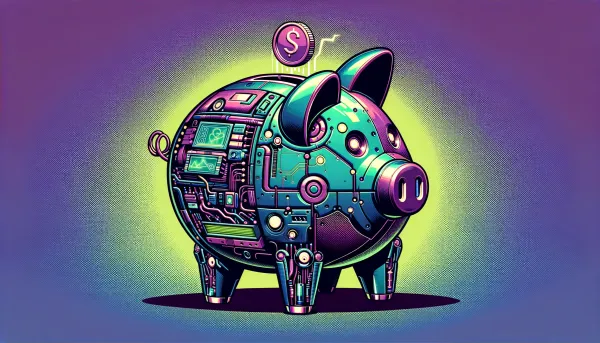Analyzing the Effects of Negative Interest Rates Across Five Economies
Negative interest rates are an extreme form of monetary policy intended to stimulate inflation or defend a currency peg. Five economies have experienced such conditions and their experiences give lessons towards the effectiveness of such strategies.

This article was originally published on Toptal
Since 2008, the developed world has seen an unprecedented period of low-interest rate environments. Interest rates are a primary tool of monetary policy, directed by a nation’s central bank to stimulate investment, employment, and inflation levels. The theory is that low-interest rates encourage more spending and investment, sparked by the opportunity cost effect of meager returns offered by cash savings accounts.
In the past, rate cuts and rises would be cyclical and mainly to the tune of the respective recessions and booms that economies go through. In recent years, this relationship has decoupled, and we have seen interest rates struggle to stimulate growth. Subsequently, some economies have taken radical steps of moving them into negative territory.
How do negative interest rates work? Well, it effectively means that lenders pay borrowers for the pleasure of taking their money. This sounds slightly disingenuous, but in reality, it is a reflection of the economic conditions where there is too much money supply and not enough investment demand.
What Nations Have Experienced Negative Base Rates?
In 2019, four nations and one currency bloc currently have a negative interest rate environment, which all began inside the past decade. In the US, the Federal Reserve cut rates for the first time in 11 years in July 2019, which some are already predicting as a foreboding sign of future negative rates stateside.
In light of the current environment, past examples of countries with sub-zero rates have been researched to determine how effective such policies can be. By looking at what has worked and what has not, it will paint a picture as to the motivations and resultant aftermaths of negative rate policy.
The countries in question that have felt the effects of negative interest rates are:
- Denmark: 2012 -
- Eurozone: 2014 -
- Switzerland: 2015 -
- Sweden: 2015 -
- Japan: 2016 -
The chart below tracks the history of these nations’ respective central bank rates over the past seven years; since 2016, they have all been negative.
History of Central Bank Base Rates for Negative Interest Rate Nations: 2012 - 2019

But first, let’s explore what these rates mean precisely.
The Importance of the Base Rate
Central banks set base rates, which can come with a variety of names such as target rate, policy rate, official bank rate, or repo rate. Essentially, these all variedly describe the bid (and offer) that the central bank will pay to licensed banks to deposit (or borrow) overnight funds. As overnight deposits to the most creditworthy institution in the nation (if a central bank becomes insolvent, then its economy will have collapsed entirely) this interest rate is effectively a country’s risk-free rate. The basis of this rate will define domestic yield curves, ranging from the government itself to corporate and consumer credit products.
Now, let’s look at the effects of negative interest rates and why central banks turned to them in the first place.
Motivation #1: Stimulating Inflation
Japan: A Failure to Address the Elephant in the Room
Following an asset bubble collapse that began in 1991, Japan had to contend with The Lost Decade of economic stagnation that some argue continued for a total of 20 years. Japan’s economy has been in first gear since its collapse, with the Nikkei 225 Index still trading at around 50% of its 1989 all-time high. Inflation (or lack thereof) has been the bane of Japan’s economy, and The Bank of Japan has tried all manners of policies such as low rates, money printing, and quantitative easing to stimulate growth.
Japan presents a compelling economic case study because it is a highly-developed, self-contained island economy. Unlike, say, countries in Europe, where financial contagion seeps across borders.
It was 1999 when interest rates first hit zero in Japan. Since then, the highest inflation recorded was 2.36% in 2014 - attributed as a one-off pre-emption to an increase in sales tax. In 2016 rates finally went negative to -0.1% and have stayed there since.
Japan is an economic case that many scholars devote years to studying. For the sake of brevity: negative rates have not worked in Japan because they have failed to address the elephant in the room of its broader structural issues. On a macro-societal level, Japan faces the following problems:
- A stalling export engine threatened by the emergence of other Asian technological hubs
- Aging demographics
- Low birth rate and inward migration to replace retiring workers
Negative rates have not stimulated the economy, as an aging population is not going to stop saving. The banks of Japan have not put money to work locally; instead, they have embarked on large (and failed) expansion plans overseas and lending their reserves into foreign assets, such as the CLO markets.
Public social spending in Japan has doubled from 1991 levels to reach 22% of GDP. The government is bloated with debt and restricted in its ability to invest in widespread structural changes to its economy due to its increasing obligations to an aging populous.
Eurozone: Compromises of Disparity
The Eurozone is a kaleidoscope of an economy, which has seen fractures post-2008 that have put many of its members on varying economic trajectories. The European Central Bank (ECB) can only directly influence the currency bloc with monetary policy; tax rates are not harmonized and are the domain of each member’s government.
The ECB’s €2.5 trillion asset purchasing program was intended to stabilize the bloc’s banks by providing willing liquidity for wide-ranging assets clogging up their balance sheets. This, along with regular repo activity, made negative rates an inevitability due to the sheer amount of money injected into the Eurozone system.
Rates moved negative in June 2014, when the ECB lowered them to -0.1% in another attempt to kickstart growth across the continent.
There is no real indication that negative rates in the Eurozone have had a positive effect. The irony of the policy was that many ECB initiatives have been intended to help banks, yet negative rates have put banks into a zombified spiral of declining margins and business model turmoil. In total, banks have paid the ECB over €20 billion in negative interest fees, which provides a tangible demonstration of its paralyzing effects.
Each country of the Eurozone is nuanced: member populations range from 500,000 to 83 million and GNI per capita from $15,000 to $76,000. For the ECB (without fiscal tools), managing inflation expectations across such a variety of economies appears to be a continual game of compromise.
Sweden: Importing Inflation
Sweden has an export-oriented economy and its central bank–the Riksbank–closely follows inflation-targeting. Unlike neighbor Denmark (discussed below), there are no explicit goals on targeting currency pegs. In efforts to drive the economy and in turn, naturally depreciate its currency, the krona, Sweden turned to negative rates in 2015.
Since 2015, the krona has depreciated by 15% against the Euro, but exports have failed to grow significantly, and corporates are hoarding profits overseas. Negative rates have not discouraged Swedes from saving; the country has the third-highest household savings rate in the world. As with Denmark, house prices have boomed, having tripled in real terms since the mid-1990s.
Sweden’s experiments have had mixed results, negative rates have certainly affected inflation, and its economy is one of Europe’s most robust. Unlike Denmark, the key to Sweden’s success has been using negative rates for a broader economic goal of export growth. Denmark’s Euro peg target means that its economy and monetary policy has a degree of surrogacy towards the ECB’s intentions.
Motivation #2: Defending Currencies
The economies and foreign policies of Denmark and Switzerland are markedly different, but both have a history of monitoring their currency’s exchange rate to the Euro. As major trading partners to the bloc and the wider-EU, it’s in their interest to avoid wide fluctuations of their currency, in order not to disrupt import/export activities.
In the aftermath of the 2008 Great Recession and various contagious debt crises in countries such as Greece, both Switzerland and Denmark became more prominent as safe-haven economies. Free from Eurozone monetary policy (and in the case of Switzerland, EU membership) for investors they were seen as credit-worthy sovereign nations, in full control of monetary and fiscal tools and yet still with favorable trading exposure to the EU (the world’s second-largest economy).
The issue for safe-haven economies is that capital inflows are clambering for safety, which means investing in liquid and risk-conservative assets. This is not particularly useful for an economy over the long run, as this kind of capital cannot be lent out by banks or put to work on transformational projects. Both Switzerland and Denmark had to deploy negative interest rates in some form as a manner to stop their exchange rates from appreciating against the Euro.
Switzerland: Safe Haven Surges
The independence and stability of the Swiss economy means that during periods of global market vulnerability, it receives vast inflows of capital into its banking system. This became particularly pronounced post-2008, culminating in a period between 2011-14 where the Swiss National Bank (SNB) intervened heavily in currency markets to weaken the Swiss franc (CHF) and maintain a pegged rate of EUR/CHF around 1.20. Intervention came in the form of selling francs and purchasing foreign-currency-denominated assets.
Eventually, this undertaking became too great to maintain, and the peg was unexpectedly released on January 15, 2015, with interest rates simultaneously cut to -0.75% to dampen foreign demand for CHF. This day, known as Frankenschock, prompted the most significant currency market swing since the 1970s, as the franc strengthened by 30% against the Euro in one day, which left a slew of casualties across broker markets.
Since that day, Switzerland is alone as being a country that has seen relatively positive effects of negative interest rates on its economic performance. Personal savers have been protected, and banks have only passed on negative rates to corporate depositors. Banks have recovered margin by pricing up mortgages, which has helped to prevent property bubbles from emerging. One sign of increasing pain from negative rates is 2019 news that banks will finally start passing on negative rates to individual savers, albeit starting with high net worth individuals.
Switzerland is, however, a very unique economy and financial system. The SNB is a rock between many hard places; as a result of its currency interventions, it has a large balance sheet of foreign-denominated assets. Selling them would result in the franc strengthening, as would any increase in interest rates. Besides, Switzerland is continuously on tenterhooks, as any world shocks will result in substantial capital inflows, which will put further pressure on the franc.
Denmark: A Game of Krones
The Danish krone (DKK) has been pegged to the German Deutsche Mark and then the Euro since 1982. Denmark’s central bank–Danmarks Nationalbank–doesn’t even have an inflation target, its goal is solely to maintain Euro parity at a 2.25% band around EUR/DKK of 7.46038. Danmarks Nationalbank was also the first central bank to instigate negative rates, making its first sub-zero cut in 2012.
After Switzerland removed peg support in 2015, capital inflows to Denmark surged. $15 billion was estimated to be arriving each month from safety seekers and currency speculators. In line with its fixed peg policy, the central bank responded by cutting rates accordingly to -0.75% and suspending government bond issuance to stimulate krone depreciation.
The consequences of negative interest rates for Denmark have been stark; since 2012, Danish inflation hasn’t moved above 1%. Danish mortgage borrowers are now even financing their houses at negative rates. The stoic resistance to defending the krone peg has caused an asset price boom fueled by low-interest rates. In 2019, Danish house prices reached their highest ever levels, growing by 4.2% on the year. A 1,500 sq foot abode in Copenhagen now costs on average $745,000. Widening inequality in the nation has been linked to the negative interest rate environment, which is not expected to see a rate rise until 2022.
How Have the Effects of Negative Interest Rates Been Limited?
1. They Create New Bubbles
The experiences of Denmark and Sweden, in particular, show that negative rates cause an increase in property prices. In times of uncertainty, which negative rates tend to imply, purchasing tangible assets–such as houses at rock-bottom rates–becomes more attractive than riskier investment choices.
A property bubble externality is not exactly the desired outcome dreamt up by policymakers. For one, locking cash up in property does not increase the velocity of money, nor generate recurring tax revenues. Secondly, it also creates wealth disparities, making it difficult for younger generations to get onto the housing ladder.
2. Consumer Psychology is Idiosyncratic
By and large, the average retail saver does not have to endure negative rates in their checking and savings accounts. Banks instead have swallowed shrinking margins between borrowing and lending, which has harmed earnings and lead to substantial restructuring efforts at institutions such as Deutsche Bank.
Banks are loathe to pass negative rates on to consumers due to the backlash and outflows that could occur. The irony for the consumer is that they will pay in other ways, such as through higher fees on products and diminished service quality born through internal cost-cutting.
As seen in a country like Japan, rates becoming negative does not immediately prompt citizens to go out and spend money lavishly. Textbooks may suggest that savers are elastic to interest rates, but in reality, people have their idiosyncratic reasons to grimly accept low-interest rates. When saving for a house, a vacation or retirement, it’s crude to think that life plans will change instantaneously off the back of a rate cut.
3. Paper Money is Slippery
One issue that has personified Japan’s prison of stagflation has been its citizens’ fondness for a cash-based economy. When interest rates are below zero, it’s to the advantage of consumers to hold money in cash away from banks. This removes it from the formal banking system and also leads to issues of personal fiscal declarations.
Corporates and high net worth individuals also shift to physical cash (or gold) when it is in their interests to do so. During the height of Eurozone uncertainty in 2012, there was a shortage of safety deposit boxes in Switzerland.
Paper money denominations are also very stubborn anchors that restrict inflation efforts. In Japan, the ¥1,000 lunch has been an anchor price for decades, with its round number, ease of payment with one banknote and nostalgic familiarity proving to be an immovable object by the tides of inflation.
Percentage Usage of Paper Money in Major Economies (2017)

The IMF proposes an innovative way of responding to a world of negative rates, which is to have an actual exchange rate between e-money (i.e., debit cards) and physical money. This rate would, in turn, affect the amount of paper money issued to bearers, as a response to the interest rate. This would ensure parity between savers and withdrawers, whereby users of paper cash take a haircut on their withdrawn amount that reflects the negative rates being worn by electronic savers.
4. Regulation Can Contradict Monetary Policy
Many question, in a world of high liquidity and low-interest rates, why banks aren’t lending more money out. This quirk highlights a weakness of central bank policy, where its desired actions can be contradicted by adherence to global regulatory standards, such as Basel III.
It is less easy for banks to turn the taps on quickly and lend money out en masse when their deposits rise. Depending on the tenor of deposits and the type of depositor, the funds may be unfeasible to lend out through traditional economy-growing ways, such as mortgages and business loans.
The increase in regulatory capital rules since 2008 has raised the stringency of banks to hold sufficient capital reserves. This dictates that they must maintain an adequate ratio between assets (loans) and their equity reserves. Some banks are trapped in a cycle where continually low profitability (from low-interest rates) inhibits their ability to build up capital reserves (retained earnings) and thus, lend more. They get stuck in a trap of having to maintain short term overnight deposits and slowly bleed profitability.
As an example of this cycle failing, in Japan, 90% of new money created by the Bank of Japan since 2013 has ended up back on deposit in the central bank.
5. Seepage is Inevitable
Monetary policy formally began in 1694 with the founding of the Bank of England. Nowadays, economies are very different beasts, with an array of domestic and international actors. They are not closed systems that can be turned on a dime in isolation. The economic lives of everyday citizens are also very different from corporations and banks, who at times, have an informational, financial, and globalized advantage. Both consumers and corporates do not act in unison, and each has different motivations that are not really captured within classical monetary policy goals.
Are Governments Addicted to Negative Interest Rates?
In June 2019 Germany’s finance agency auctioned 10-year Bunds (government bonds) at a yield of -0.24%. The German state can now invest proceeds into its economy for a decade and be paid by its lenders for the undertaking. What is even more staggering is that Germany’s lenders made their decision on an informed assumption that interest rates will remain negative until 2030.
The negative yields enjoyed by nations such as Germany now constitute over 20% of the global bond market. The shift in yields over the past 20 years has been tectonic.
Share of Global Bond Market by Yield Bucket: 1996 - 2019

For some governments, the low rate environment has agreeable circumstances. Along with cheaper borrowing costs, there are also feel-good factors from stock markets being pushed to record highs. The high liquidity and desperation for yield that can’t be found in fixed income products are forcing savers to take increasing bets on stocks. Central banks can keep rates low and use the dopamine effect of asset purchasing schemes to numb economic shocks.
It is a dangerous precedent to forecast that low rates and liquidity injecting QE programs are the new-normal into perpetuity. The impact of the past decade will be felt most in the future, especially for consumers in the middle-to-lower classes. The long-term impact of negative interest rates on depleting savings rates and increased household debt will be felt most when current generations retire in the future. Kicking the can down the road only works if you walk in a straight line.




